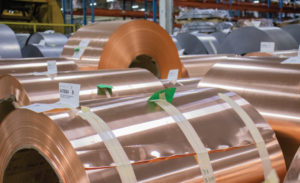Top Trends in Home Decor Featuring Stylish and Useful Copper Products
Top Trends in Home Decor Featuring Stylish and Useful Copper Products
Blog Article
How Copper Products Add To Sustainable Practices in Various Fields
Copper items are progressively identified for their substantial payments to lasting techniques throughout multiple industries, driven by their integral buildings such as recyclability, performance, and toughness. In renewable resource systems, for instance, copper boosts the performance of solar and wind modern technologies, while its application in construction minimizes waste with durability. The material's antimicrobial qualities provide encouraging benefits in medical care settings. As markets seek to adopt more sustainable practices, the role of copper could prove pivotal in achieving ecological objectives. What effects might this have for future developments in sustainability?
Copper in Renewable Power
Copper plays an essential role in the development of eco-friendly power innovations, acting as an essential conductor in various applications. Its outstanding electrical conductivity and resistance to rust make it an optimal product for electric circuitry, which is crucial in solar panels, wind turbines, and power storage space systems. In solar photovoltaic systems, copper is used in the affiliations and circuitry, allowing reliable energy conversion from sunlight to electrical energy.
In wind energy, copper is essential to the generators and transformers that transform kinetic power into electrical power, guaranteeing ideal performance and reliability. Additionally, the need for electric lorries (EVs) is raising, with copper being a crucial component in batteries, motors, and charging infrastructure. The transition to EVs substantially enhances the need for copper, as these cars usually utilize 4 times a lot more copper than conventional internal burning engine vehicles.
As the world seeks to mitigate climate modification and change to lasting energy sources, copper's duty ends up being significantly crucial. The material not just boosts the effectiveness and longevity of eco-friendly power systems however also sustains the broader objective of reducing greenhouse gas exhausts and promoting a sustainable future.
Eco-Friendly Building Products
In the last few years, there has been a significant shift towards the fostering of environment-friendly building materials in response to growing environmental worries. This modification is motivated by the demand for sustainable choices that reduce eco-friendly footprints while maintaining architectural integrity and aesthetic appeal.
Copper, known for its toughness and recyclability, has emerged as a key gamer in this industry. It can be utilized in roofing, pipes, and electrical systems, adding to energy effectiveness and reducing waste. Copper's long life implies fewer replacements over time, additional improving its sustainability account.
In addition, materials such as bamboo, redeemed timber, and recycled steel are getting appeal. These options not just provide minimized ecological influence but additionally promote source conservation. As developing codes increasingly stress sustainability, architects and home builders are integrating these products right into their jobs, cultivating advancement in layout.
The enhancing adoption of green construction materials reflects a broader dedication to sustainability in the built atmosphere. By prioritizing these materials, the building and construction market can dramatically reduce its carbon footprint, align with regulatory criteria, and sustain a much healthier ecological community for future generations. This fad marks a crucial action towards an extra lasting future in building and construction.
Copper's Duty in Medical care
Current research studies have highlighted the significant role of copper in healthcare setups, specifically due to its antimicrobial buildings. Copper surfaces have been shown to lower the presence of pathogens, including infections and bacteria, by approximately 99.9% within a short period. This amazing effectiveness makes copper a vital product for high-touch surfaces in hospitals, such as doorknobs, bed rails, and IV poles, thereby contributing to improved infection control measures.
Along with its direct antimicrobial results, copper additionally contributes in the wider context of health center sustainability (Copper Products). By including copper into clinical equipment and furnishings, healthcare facilities can decrease the incidence of healthcare-associated infections (HAIs), which not just boosts patient outcomes but also lowers the prices associated with prolonged medical facility keeps and extra therapies
Additionally, copper's toughness and recyclability line up with sustainable techniques, enabling accountable source administration. As medical care look at this website systems significantly focus on both client safety and ecological stewardship, the integration of copper items is ending up being much more common. This double advantage emphasizes copper's vital payment to a much healthier, more secure, and more sustainable healthcare setting.
Sustainability in Transportation

Additionally, copper's durability and rust resistance add to the long life of transportation facilities (Copper Products). In rail systems, for circumstances, copper parts boost the reliability and performance of signaling and power systems, necessary for lowering hold-ups and power consumption. In addition, copper's duty in eco-friendly power systems, such as solar and wind, supports sustainable transport solutions by supplying clean power for electrical transit alternatives
Investments in copper modern technology not just foster sustainability yet also promote economic development and job development in environment-friendly markets. As sectors aim to meet rigid ecological guidelines, the application of copper products in transportation arises as a critical strategy in attaining sustainability goals and advertising a cleaner, more reliable future.
Copper and Round Economic Situation
As the world progressively welcomes read more sustainability, the duty of copper in the circular economic climate ends up being ever a lot more considerable. Copper's inherent homes-- such as its sturdiness, conductivity, and recyclability-- placement it as an essential product in a resource-efficient economic climate. The round economy aims to decrease waste and take full advantage of source use with recycling and reusing materials, and copper master this respect.
The metal can be recycled indefinitely without loss of top quality, making it a suitable candidate for lasting practices throughout various industries, including building and construction, electronics, and renewable energy. By reprocessing and recovering copper from end-of-life products, sectors can significantly minimize the need for virgin products, therefore decreasing ecological effects associated with mining and handling.
Moreover, the combination of copper into round economy structures not just preserves sources but additionally fosters development. Companies that focus on copper recycling add to a much more lasting supply chain, boosting their competitiveness while lining up with regulative needs and consumer choices for ecologically liable items.
Conclusion
To conclude, copper items substantially add to sustainable methods throughout several sectors. Their necessary function in enhancing renewable energy technologies, promoting eco-friendly building materials, sustaining infection control in medical care, helping with sustainable transportation, and embodying the concepts of a round economy highlights the adaptability and significance of copper. By integrating copper into different applications, markets can accomplish higher effectiveness, minimize ecological influence, and line up with international sustainability objectives, eventually cultivating a much more sustainable future.

Copper's excellent conductivity makes it a recommended material in electric lorry (EV) systems, boosting energy performance and performance. Furthermore, copper's function in eco-friendly energy systems, such as solar and wind, sustains lasting transport solutions by supplying tidy power for electric transportation options.
Their necessary duty in improving sustainable energy modern technologies, advertising environment-friendly building materials, supporting infection control in medical care, promoting sustainable transportation, and symbolizing the concepts of a round economic climate emphasizes the convenience and value of copper.
Report this page